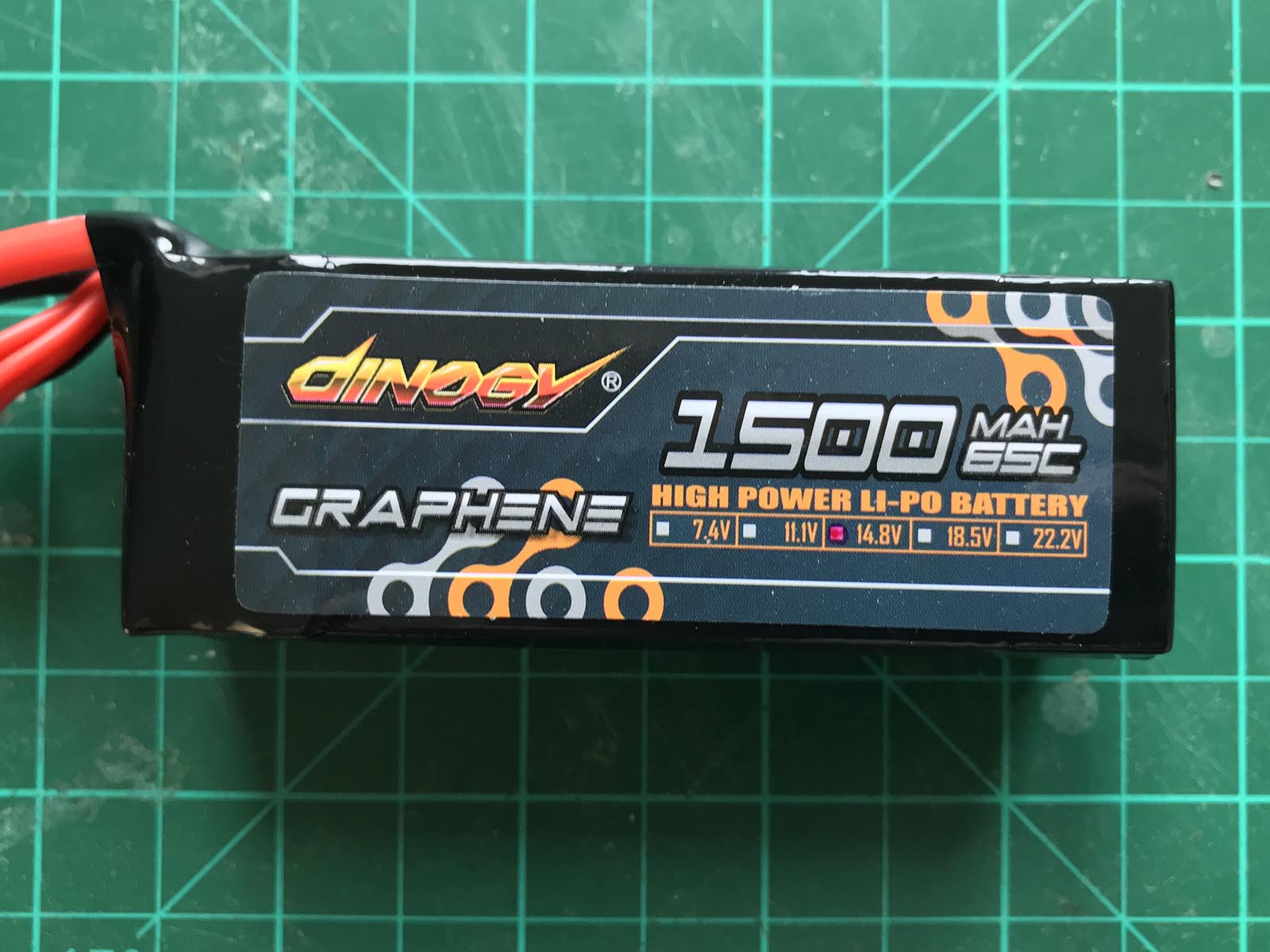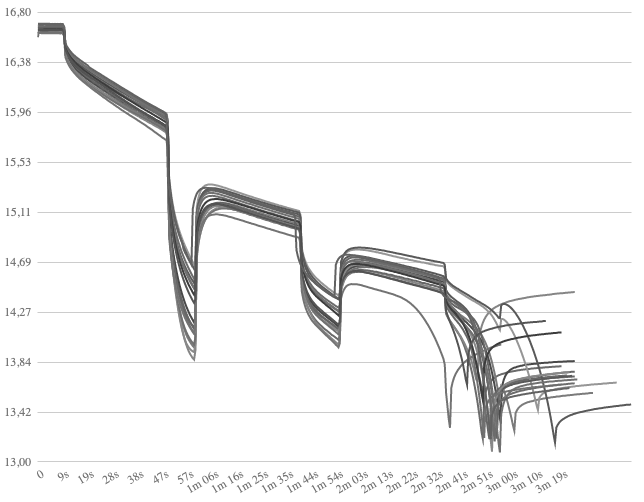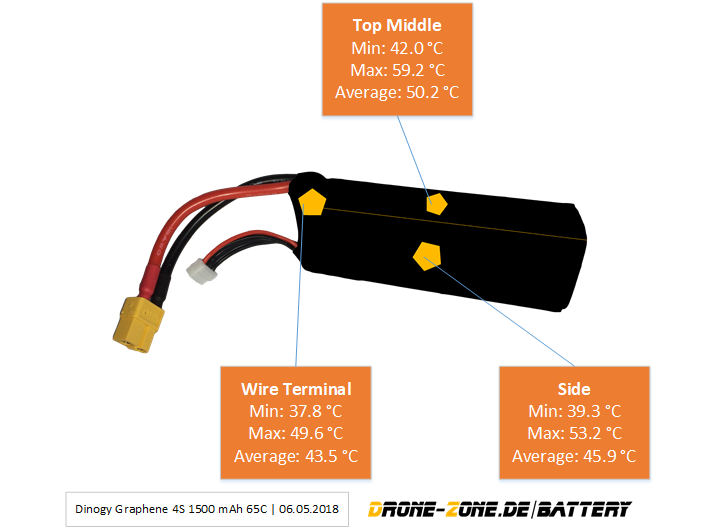It has been some time since my last Dinogy battery review. Now that the flying season is coming on strong in most parts of the world, we also finally can expect new FPV racing battery products. No surprise on this matter, that Dinogy just sent me their new GRAPHEN series, developed to be a cost-efficient solution for more price-sensitive pilots. This review is looking at the newest version of the 1500 mAh of the Dinogy Graphene 4S 65 C pack.
Appearance
The brand new Dinogy Graphene series comes in the usual card board box, packed within bubble wrap and protected by a layer of foam on the bottom. Dinogy lipos have always been one of the products with the best packaging – so no surprises here. The battery itself, aiming to be cost-efficient, is packed in an all black shrink wrapping. The red honey-comb style materials on the sides are still in place, identifying the battery as a Dinogy product. What I can’t praise enough is the fact that even the economical Dinogy Graphene series has all the important information printed on a small sticker, which is attached to the back of the pack. The overall built-quality is very good – nothing to worry about.
Technical Design
The Dinogy* Graphene 65C pack is a standard 4S1P config flight pack for high power use. It utilizes the newest generation graphene cell chemistry. An extra layer of carbon particles is added to minimize internal resistance and hence maximize possible current draw. The new Graphene series now is rated up to 65C constant load, which is 10C less than the last years MEGA series.
Build Quality: Very good. Pack feels very well made on the outside. Connection terminal looks solid. The bright red honey-comb materials feels like it offer good protection on the sides.
Plugs: The Dinogy pack comes with standard XT60 connectors* equipped.
Cables: L&E uses 12 AWG wires on this packs. The high flexible silicon layer is rated up to 200°C. Cable length is about 7.5 centimeters.
Balancing plugs: Standard XT-system. Balance wires are short (2.5 cm) which is a benefit in terms of getting them out of the prop-range on the aircraft. Both, main power cables and balancer wires, are connected to the top edge of the pack.
Technical Details
| Manufacturer | L&E Battery Industrial* |
| Type | Dinogy Graphene 65C |
| Cell chemistry | Lithium Polymere (LiPo) |
| Cell type | Dinogy Graphene enabled chemistry |
| Cell count | 4 |
| Pack configuration | 4S1P |
| Capacity | 1500 mAh |
| Max. charge current | 7.5 A |
| Discharge current continuous | 97.5 A |
| Max. discharge current | - |
| Weight (incl. plugs) | ca. 176 grams |
| Measurements listed | 27 x 34 x 87 mm |
| Measurements measured | 34 x 29 x 94 mm |
| Price | US-$ 19 |
| Dealer | - |
| Note | This battery has been directly donated by the manufacturer / distributor for review purposes. |
Impressions





(Click to enlarge.)
Break-in documentation
The battery followed the standard break-in-process: The pack is charged at a rate of 1C until CV-phase ends with current of 1/10C. The break-in phase consists of four charging cycles at 1C and four corresponding discharges at 1 C / 4C / 10C and 20 C.
Anomalies: No anomalies during break-in.
Charging process
CV-Phase is short on this cell type. Balancing in normal mode took 2:20 min. Cell drift during charge was unobtrusive. This is for 1C charge (1.5 A).
Load Testing
The main part of this battery test will consists of different load test settings showing the battery performance. Constant load testing is used to judge the advertised C-ratings as well as look at cell drift under high loads. We also check on internal resistance once more. Next up is the dynamic current test, which simulates a „real“ flight with changing (=dynamic) loads. For test methodology please check the dedicated methodology page!
Constant Load Testing
Constant load testing follows a certain load pattern of different constant currents. Base load is 10 C. Current pulses at 50 C, 35 C, 20 C and 30 C are maintained for time intervals between 10 and 20 seconds. For more details please refer to the test methodology page.
Capacity Usage
During this test the pack delivered 1094 mAh. This is 72,9 % of nominal capacity. A good result.
Average cell voltages
The following table lists the average voltages per cell, of the total pack, as well as the averaged value per cell as fraction of total voltage during phase of active load.
| Cell 1 | Cell 2 | Cell 3 | Cell 4 | Total | Average per cell | |
| Avg. Voltages | 3.749 V | 3.748 V | 3.752 V | 3.749 V | 14.998 V | 3.750 V |
Just looking at average values the Dinogy pack performs fine. All cells stayed well above 3,7 V on average. An average value above 3,74 V / cell can be considered very good.
Focus Voltages
Exceptionally interesting when testing a battery under a constant load for a longer period of time: the lowest voltage per cell just before load impulse is disabled. On top, you should have look at voltage recovery rate, that is: how fast do cell voltages rise again once load impulse is cut.
| Phase | Cell 1 | Cell 2 | Cell 3 | Cell 4 | Total |
| End of 50 C | 3.572 V | 3.570 V | 3.609 V | 3.622 V | 14.373 V |
| End of 35 C | 3.536 V | 3.537 V | 3.555 V | 3.560 V | 14.187 V |
| End of 20 C | 3.316 V | 3.342 V | 3.247 V | 3,290 V | 13.978 V |
| End of 30 C | - | - | - | - |
Voltage sag is very low on the Dinogy Graphene 65C 1500 mAh pack. No cell went below 3,5 V/cell benchmark on first two load cycles.
Average voltage recovery per second
Those values are specific to the test setting and not valid for the pack in general! Still they allow an estimated guess about how fast voltages rise again after current spikes.
| Cell 1 | Cell 2 | Cell 3 | Cell 4 | Total | |
| Avg. Recovery | 0.0347 V / s | 0.0344 V / s | 0.0210 / s | 0.0190 V / s | 0.0888 V /s |
Voltage recovery is quick for the new Graphene 1500 mAh 65 C battery.
IR-Measurement
IR measurement is conducted using the four current pulses. Resistance for each cell is calculated in all four discharge phases. Shown values are averaged to cancel out different temperature points due to different discharge states during measurements.
| Cell | 1 | 2 | 3 | 4 | Total |
| Resistance [mΩ] | 2.64 | 2.58 | 2.226 | 2.32 | 9.80 |
Interpretation: The internal resistance of 2.45 mΩ average per cell indicates a „true“ C-rating of around 40 C (60.6 A). This is on the conservative side and represents a current draw that will make the pack last for a long time. Overall performance can be described as very high. The pack achieved equal or higher values compared to competitor products claiming to have 75C or higher ratings.
Cell drift under load
| Discharge Phase | 50 C | 35 C | 20 C | 30 C |
| Max Cell drift (V) | 0.024 V | 0.025 V | 0.095 V | - |
Cell drift is low on the new Dinogy Graphene 65 C pack during main discharge phase. All cells are matched well, cell 1 seemed to be a little off, though.
Key Temperature Facts
Temperature Development
Max. temp during discharge was around 59.2 °C on top of pack. Note that heating of stressed LiPo packs will continue for some more time even when load is cut.
Market Comparison
The following chart shows all reviewed LiPos in the same product segment for direct comparison of performance. Higher values under load are better.
Constant 25 C Discharge
Pretty much a standard benchmark in the LiPo industry.
Cut-Off /warning value for this battery should be chosen 3.5 V minimum. After this point voltage drops quick. The battery provided 1094 mAh (72,9 %) during the 25 C discharge.
Market Overview
Comparison of different reviewed 1500 mAh batteries under 25 C load.
Dynamic Load Testing
The dynamic load testing setting consists of two separate discharge scenarios that have been developed of two different real-life FPV flights. Pattern one represents a high speed low proximity flight around the open field with some hovering to the end. Average load is around 22 A. Second pattern is a free-style flight around trees in the park with some current spikes near 70 A. Average load on this flight is around 13 A due to longer floating periods.
Capacity Usage
During the test of pattern 1 the pack delivered 1101 mAh. This is 73.4 % of nominal capacity. Good! In patter 2 testing 1068 mAh (71.2 %) could be used until first cell reached cut-off voltage.
Market Comparison
The following charts give an overview of all tested packs in the 1500 mAh class so far.
The last chart of this review sums up the usable capacity during all four load scenarios. Please note that this is only the capacity consumed by the electronic load! There are losses due to heating of the pack, which could be approximated (see testing methodology page). All four tests are cut when any cell goes below cut-off voltage of 3,3 V (or pack goes above 58 °C on any of the three probes). If you would push further and go down to 3,0 V/cell you will be able to squeeze out some mAh more, but at the cost of excessive heat generation and shortening of pack life-span. This value will most likely differ from what you get when flying on a quad as most people don’t monitor voltage on a per cell basis and therefore don’t even notice if voltage drops below 3,3 V/cell during punsh-outs (what’s not necessarily a good thing, though). For comparison, used capacity until 3,3 V/cell is reached is the base line in all battery reviews on Drone-Zone.de.
Conclusion
The all new Dinogy Graphene* 4S 1500 mAh 65C battery is a small sized pack with a capacity to weight ratio of 8.5 mAh/g. As other graphene enabled packs this battery tends to be just a little heavier than a “standard” lipo. Build quality of this new „best value“ battery is still excellent. The pack is rectangular shaped and keeps it shape under every load situation – no puffing what so ever! Voltage stability is good on the Graphene 65C version. Cut-off should be chosen at 3,5 V / cell minimum.
Usable battery capacity is decent, higher priced pack will yield in a little more output, though. Cell matching is fine, nothing to complain about here.The rating of 65C is a bit over the top, of course. I would rate this pack at very amazing 40 C continuous. This allows you to pull around 60.6 A without having to worry about the packs health too much. More than enough head room for most of the applications out there and a good balance between performance and costs. As you can see in the dynamic loads higher current spikes are handled well. Compared to the 1300 mAh version, the 1500 mAh Dinogy Graphene* pack tended to get a lot warmer.
For around 19 US-$ (retail price) this pack is certainly will hit the market running. It outperforms the some of the competitor products without any problems, but keeps in line behind the Dinogy MEGA and ULTRA series* (nothing other than I would habe expected). In the end 19 dollars (US) are almost a no-brainer, especially for a battery that might be used regularly in training or freestyle situations around the park, where there is no competitive pressure as on the race track.
Other packs of this line up tested:












